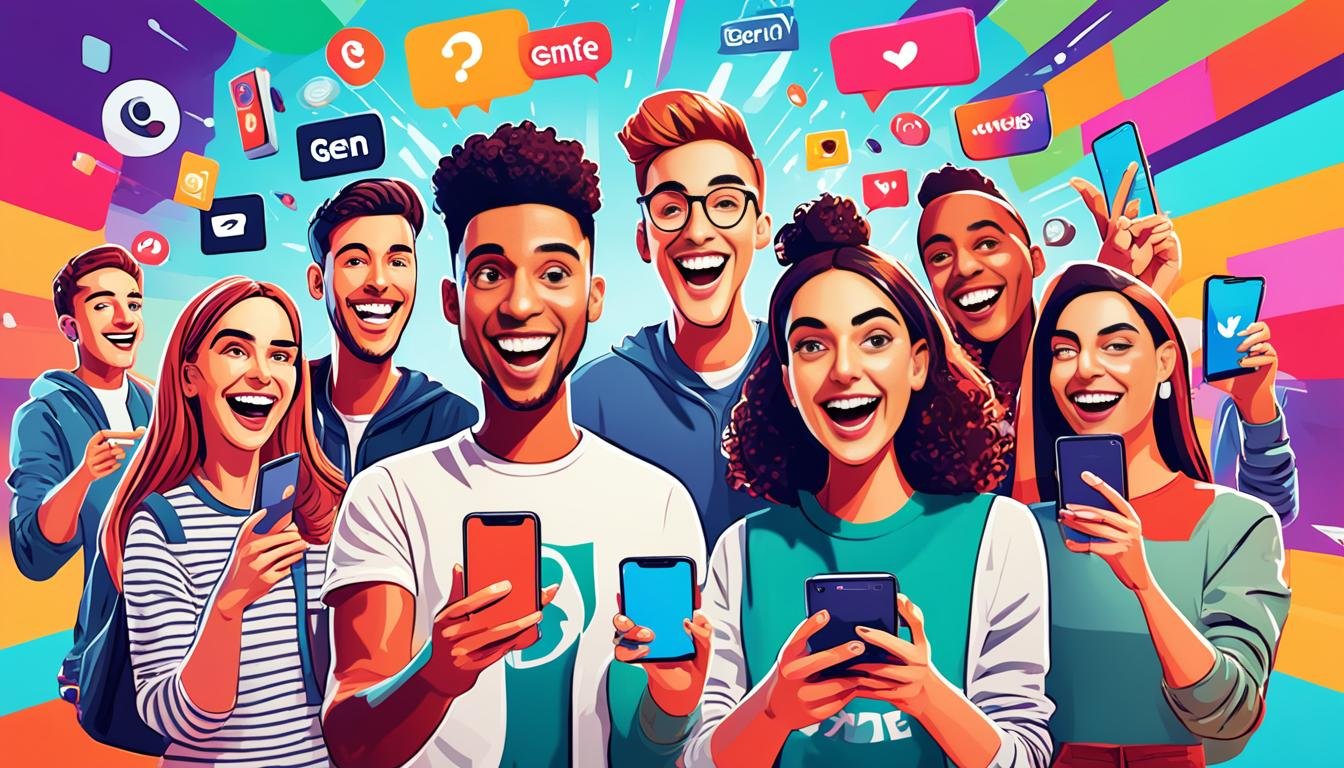Marketing to Gen Z: Understanding and reaching younger audiences.
Did you know Gen Z, about 20% of the US population in 2023, has $360 billion to spend? They spend over four hours daily on social media. This makes them key for marketers wanting to grab their attention and loyalty.
But, marketing to Gen Z is different. Aleks Stojanovic from Trndsttrs says being real and relevant is key. Gen Z, having grown up with lots of info, spots fake ads fast. A big 41% of them like brands that answer quickly and care about them. And 73% think brands should speak up on big issues.
To connect with Gen Z, brands should be creative, not just sell. They should show they’re real through fun or learning content. Gen Z watches videos on TikTok and YouTube. They also trust influencers more than big brand messages.
Key Takeaways
- Gen Z has $360 billion to spend and makes up 20% of the US population.
- They spend over four hours a day on social media, making it a key spot for ads.
- Being real and relevant is key to reaching Gen Z, who quickly ignores old-school ads.
- Brands should stand for big social causes, as 73% of Gen Z cares about this.
- Influencer marketing works well since Gen Z trusts influencers over big brand ads.
- Creative content is better than direct sales pitches for connecting with Gen Z.
Understanding Gen Z Demographics
Generation Z, with about two billion people, makes up 30% of the world’s population. By 2026, they will be over a quarter of the world’s people and have more than $44 billion to spend. This big spending power changes the market a lot.
In the U.S., 13.6% of people are aged 15-24. Canada has 12.9%, and the UK has about 16%. India has the most Gen Z, with nearly 472 million under 24. Southeast Asia varies, from 14% in Thailand to 22% in the Philippines.
More and more Gen Z will join the workforce, making up 27% of the world’s jobs soon. In the U.S., 7.3 million Gen Z work full-time, and 6.3 million work part-time. They will change the work world and what people expect.
Gen Z is very diverse in ethnicity. In the UK, 54% are from non-white backgrounds. They will be the most diverse generation in America by 2026, with most being nonwhite.
They spend about 3.4 hours daily on social media, using YouTube, TikTok, and Instagram a lot. 63% of Gen Z likes to talk to businesses on social media. This shows how big social media is for them.
Gen Z has a lot of money to spend, showing they are financially independent. Over 70% of them have a steady income. So, knowing about Gen Z is key for businesses to reach them.
Characteristics of Gen Z Consumer Behavior
Understanding Gen Z consumer behavior is key for businesses aiming at this powerful generation. Born between 1997 and 2010, they are now 11 to 24 years old. This makes them a crucial and growing part of the workforce with more buying power.
Values and Priorities
Gen Z cares deeply about a brand’s ethics and responsibility. They are deeply moved by social issues and community concerns. They choose brands that are real, open, and committed to doing good.
For them, buying things means picking brands that share their values. This includes brands that support inclusivity and care for the environment.
- More pragmatic in financial matters compared to millennials
- Strong belief in social causes and corporate responsibility
- High importance on corporate ethics
About 66% of Gen Zers believe communities are built by shared causes and interests, not by money or school. This shows they value deep connections over old social norms.
Spending Habits
Gen Z shops smartly, looking at the value and usefulness of products first. They lean towards STEM subjects and are cautious in their spending. Despite being online savvy, they still like shopping in stores.
- Product choice, availability, convenience, and value are key factors
- High tendency to shop via social media
- Influential in parent purchasing decisions
Businesses aiming at Gen Z should focus on personal rewards and real experiences. Using an omnichannel approach with social responsibility works well with their habits and values. This group’s impact goes beyond their spending, shaping trends and expectations for brands.
Effective Strategies for Gen Z Marketing
Gen Z makes up 26% of the world’s population and a quarter of the workforce in 2023. They have a big impact on today’s market. Using
First, it’s key to share brand values that match Gen Z’s desire for ethical actions. These young people pay close attention to how brands affect society. They like companies that are open about their positive impact. In fact, 73% of Gen Z values brands that are inclusive, which leads to better brand loyalty.
It’s also vital to focus on real and impactful brand efforts, not just pretending to care. *Gen Z advertising campaigns* should really tackle social issues. Three-quarters of this generation will stick with brands that speak up on issues they believe in. But, brands need to be careful; 13.7% of Gen Z doesn’t want to see LGBTQ+ issues pushed too hard in ads.
Reaching out to Gen Z through digital channels is key. They prefer social media over traditional media. Sites like TikTok, used by 67% of U.S. teens, and Instagram, used by 62% of teens, are big for them. Personalized ads, liked by 87% of Gen Z, really help brands connect with them.
Offering deals and value is important too. 62% of Gen Z likes to buy clothes on sale. This group has $360 million to spend, showing their big buying power. Using contests, referral rewards, or raffles can also help get more people involved and improve marketing.
Quality of products matters a lot to Gen Z, with 69% seeing it as a trust factor. But, picking the right platforms for Gen Z advertising campaigns is also crucial. Instagram, TikTok, and Snapchat support social shopping and offer useful data for marketing. Working with influencers can also be a big win; for example, fun tutorials by Fenty Beauty caught Gen Z’s quick attention, lasting only 8 seconds.
Creating Authentic and Relevant Content
To connect with Generation Z, brands must focus on authentic content creation. This group, aged 27 to 15, values marketing that feels real and connects with their lives. Brands are now targeting this age group because they have more money to spend.
Storytelling Techniques
Storytelling is a key way to reach Gen Z. They like content that makes them feel something, like laughter or a deep connection. Real stories about everyday people and issues are best.
Nike’s “Dream Crazy” campaign is a great example. It told stories of overcoming challenges and fighting for what’s right. This really spoke to young people.
User-Generated Content
Getting people to create and share their own content is vital for brands. Gen Z spends a lot of time on social media sites like Instagram, TikTok, and YouTube. They trust reviews from friends and peers more than ads.
By letting users share their own stories, brands can spread their message further. Guess’s #InMyDenim campaign on TikTok is a good example. It got a lot of attention and made people more aware of their denim line.
The Role of Social Media in Reaching Gen Z
Social media is key to connecting with Generation Z, born between 1997 and 2012. Almost all Gen Z have a social media account and spend about 2 hours and 22 minutes daily on these sites. This shows how vital it is to use social media to talk to Gen Z.
Platforms like YouTube, Instagram, TikTok, and Snapchat are big hits with Gen Z. A 2022 survey found 54% of them spend over four hours daily on social media. This shows the need for strong social media marketing plans. Brands must be real to connect with Gen Z, as 90% value true experiences when choosing brands.
Short videos, Stories, Reels, and AR experiences are great for catching their attention. These formats are perfect for Gen Z’s love of lively and interactive content. Brands can boost engagement by using polls and challenges, building a strong community and loyalty.
About 80% of Gen Z and millennials buy things they see on social media. This shows how big an impact social media marketing has. Good ads and promotions on these platforms can help brands get noticed and increase sales. Also, 75% of Gen Z looks to social media for buying tips, making a strong online presence crucial.
In summary, knowing how to engage with Gen Z on social media is key for modern marketing. By using interactive ways to communicate and tapping into social media’s power, brands can grab the attention of this important group.
Building and Leveraging Influencer Partnerships
Influencer marketing is key to reaching and engaging with Generation Z. Over 70% of Gen Zers follow influencers on social media. By picking influencers who share the brand’s values, companies can create strong bonds. These bonds boost marketing and make the brand more real.
Finding the Right Influencers
Finding the right influencers is crucial for influencer marketing success. Look for people who are real and trusted by Gen Z. The best partnerships share values and connect deeply with the audience. Tools help match influencers with the right audience, focusing on engagement and demographics.
It’s vital to have diverse and inclusive partnerships. Gen Z likes campaigns that show everyone’s voice. This approach makes the brand more relatable and appealing.
Co-Creating Content
After picking influencers, work together on content. This makes the campaign feel more real and engaging. Influencers can show products in a way that feels true, drawing in followers and boosting sales.
Short videos are a hit with Gen Z, thanks to their short attention spans. TikTok, YouTube Shorts, and Instagram Reels are great for these. They let influencers make fun, engaging videos that speak to their fans.
Working together on content builds a real connection with Gen Z. This method is key for brands wanting to succeed with Gen Z.
Engaging Gen Z on Emerging Platforms
Reaching Generation Z on new social sites like TikTok, Instagram Reels, Snapchat, and Discord is key. They make up about 30% of the world’s people and will soon be a big part of the workforce. Brands need to understand and use these platforms well.
TikTok and Instagram Reels
Using TikTok and Instagram Reels is now vital for reaching Gen Z. Brands do well by joining in on trends and making short, fun videos. Aerie’s REAL campaign on these sites really connected with Gen Z, showing how important it is to share values they care about.
Duolingo also caught the eye of young people with its funny and unique ads on TikTok. This shows that being real and creative is what works best.
Snapchat and Discord
Snapchat and Discord are great for connecting with Gen Z in special ways. Snapchat’s filters and interactive stuff make experiences feel real. Discord helps build communities where people can talk and share easily. Brands need to get how these platforms work to keep Gen Z interested.
For example, Spotify’s Wrapped campaign got a huge reaction, with 425 million tweets. This shows how making things fun and engaging works well with young people on these sites.
It’s clear how important new social platforms are. Brands that use them well will keep connecting with Gen Z and building loyalty.
Marketing to Gen Z: Tips and Best Practices
Gen Z is a big deal in today’s market, with about 2 billion members worldwide and 27% of the U.S. population. To reach them, you need to know what they like and how they behave. Here are some key Gen Z marketing tips and best practices for Gen Z campaigns:
Being quick and open to trying new things is key. Gen Z’s attention span is just about 8 seconds, so your content must grab them fast. Use videos and pictures to keep them interested and get your message across quickly.
Being real and honest is a big plus. Gen Z values their privacy a lot, so marketing that respects their privacy can build trust. Make sure your brand supports the causes they care about, as most of them will back brands that do too.
Make sure your content fits the platforms Gen Z uses most. Since most of them get their news from social media, using TikTok, Instagram Reels, and Snapchat can help you reach them better. Use humor and be real to connect with them and get them involved.
Using content made by users is a smart move. For instance, Fenty Beauty’s #TheNextFentyFace campaign on TikTok got people talking and showed how well this works. Also, working with influencers is crucial, as 65% of Gen Z listens to what they say.
Also, adjust your brand to fit the fast-changing online world. Most Gen Zers like a mix of online and offline marketing, so make sure your strategies cover both. Offering rewards and personalized content can also boost engagement, as they like unique experiences.
In short, using these Gen Z content optimization tips can help you connect with this powerful group. Marketers need to keep up with trends and be flexible to meet Gen Z’s changing tastes.
Adapting Your Brand to Gen Z Trends
To connect with Gen Z, brands need to understand their changing tastes in fashion, lifestyle, tech, and entertainment. Born between 1997 and 2012, this group is changing how brands interact with them. They are super tech-savvy and value being real and caring about social issues.
Fashion and Lifestyle
Brands should keep an eye on what Gen Z likes in fashion and lifestyle. They care a lot about the planet and being inclusive. In fact, 61% of them are willing to spend more on products that are good for the earth and fair to everyone.
Also, 77% likes brands that support gender equality online, and 71% wants to see more diversity in ads. With their spending power growing, fashion brands must share these values. This means using eco-friendly materials, supporting social causes, and showing diverse faces in ads.
Technology and Entertainment
Tech trends play a big role in how Gen Z interacts with brands. They are 29% more focused on making money and being ambitious than older folks. So, they look for unique and tailored online experiences.
Using social media and influencer marketing can make a brand more credible and reach more people. Podcasts are also a hit with them. Plus, making content that feels personal through data can really get them engaged.
Adding these tech trends helps brands get noticed and build a community with Gen Z. This leads to more loyalty and ongoing interest in the brand.
Conclusion
Marketing to Gen Z needs more than old-school tactics. It calls for a big change in marketing that speaks to their unique likes and ways. They grew up with the internet, social media, and smartphones. So, they look for real connections with brands that share their values.
Brands must be real, open, and care about social and environmental issues to win over Gen Z. It’s not just about selling products. It’s about showing you share their values. Using creative stories, working with influencers, and offering fun, interactive experiences can help.
Since Gen Z has a short attention span, content should be quick and catchy. Think videos under 60 seconds that grab their attention right away. Social media sites like TikTok, Instagram, and YouTube are key to reaching them.
Brands need to have a strong online presence on these platforms. Fast, helpful customer service and building online communities where people feel important are also key. By being innovative, empathetic, and truly connected, brands can make a mark with Gen Z. This could lead to a big impact on their wallets, as they’re expected to spend $2.43 trillion by 2026.
Source Links
- How to make sure you’re marketing to Gen Z the right way
- Guide to Gen Z: What matters to this generation and what it means for marketers
- How to Market to Gen Z | Big Sea
- Understanding Gen Z: Insights into the Newest Consumer Market. | Kadence
- 18 Gen Z Characteristics & Stats for Marketers
- Gen Z Consumer Behavior: What You Need to Know | Talon.One
- ‘True Gen’: Generation Z and its implications for companies
- Gen-Z 101: A Marketing Guide To Connecting With The Next Generation Of Consumers
- Top 7 Gen Z Marketing Strategies to Maximize Your Brand Impact
- 5 Gen Z Marketing Strategies To Implement in 2024 | Later
- Legend Web Works
- Marketing to Gen Z: Authentic Strategies for the New Digital Age
- How Gen Z Are Using Social Media
- The Role of Social Media in Gen Z’s Purchasing Decisions. | Kadence
- Marketing to Gen Z: Capturing the Attention of the Next Generation
- 3 Lessons from Marketing to Gen Z that Apply to Millennials
- Marketing to Gen Z: Everything You Need to Know (+ Examples) – Billo
- Marketing To Gen Z: Ignite Engagement And Drive Results
- Gen Z Marketing Tactics | SheerID
- Marketing To Gen Z: How To Do It The Right Way
- Marketing to Gen Z: How to Get It Right
- Council Post: How Brands Can Adapt Their Content Strategies To Resonate With Gen-Z
- Adapting Brand Strategies for the Gen Z Market
- Marketing to Gen Z: Strategies for Success in 2024
- Understanding Generation Z: Marketing Strategies for the New Consumer Wave
- Marketing to Gen Z in 2023
- A Marketer’s Guide to Generation Z (Gen Z) in 2024







